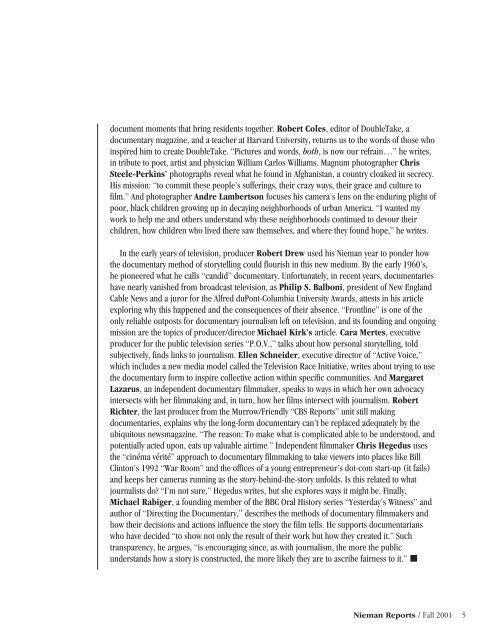Download - Nieman Foundation - Harvard University
Download - Nieman Foundation - Harvard University
Download - Nieman Foundation - Harvard University
You also want an ePaper? Increase the reach of your titles
YUMPU automatically turns print PDFs into web optimized ePapers that Google loves.
document moments that bring residents together. Robert Coles, editor of DoubleTake, adocumentary magazine, and a teacher at <strong>Harvard</strong> <strong>University</strong>, returns us to the words of those whoinspired him to create DoubleTake. “Pictures and words, both, is now our refrain…” he writes,in tribute to poet, artist and physician William Carlos Williams. Magnum photographer ChrisSteele-Perkins’ photographs reveal what he found in Afghanistan, a country cloaked in secrecy.His mission: “to commit these people’s sufferings, their crazy ways, their grace and culture tofilm.” And photographer Andre Lambertson focuses his camera’s lens on the enduring plight ofpoor, black children growing up in decaying neighborhoods of urban America. “I wanted mywork to help me and others understand why these neighborhoods continued to devour theirchildren, how children who lived there saw themselves, and where they found hope,” he writes.In the early years of television, producer Robert Drew used his <strong>Nieman</strong> year to ponder howthe documentary method of storytelling could flourish in this new medium. By the early 1960’s,he pioneered what he calls “candid” documentary. Unfortunately, in recent years, documentarieshave nearly vanished from broadcast television, as Philip S. Balboni, president of New EnglandCable News and a juror for the Alfred duPont-Columbia <strong>University</strong> Awards, attests in his articleexploring why this happened and the consequences of their absence. “Frontline” is one of theonly reliable outposts for documentary journalism left on television, and its founding and ongoingmission are the topics of producer/director Michael Kirk’s article. Cara Mertes, executiveproducer for the public television series “P.O.V.,” talks about how personal storytelling, toldsubjectively, finds links to journalism. Ellen Schneider, executive director of “Active Voice,”which includes a new media model called the Television Race Initiative, writes about trying to usethe documentary form to inspire collective action within specific communities. And MargaretLazarus, an independent documentary filmmaker, speaks to ways in which her own advocacyintersects with her filmmaking and, in turn, how her films intersect with journalism. RobertRichter, the last producer from the Murrow/Friendly “CBS Reports” unit still makingdocumentaries, explains why the long-form documentary can’t be replaced adequately by theubiquitous newsmagazine. “The reason: To make what is complicated able to be understood, andpotentially acted upon, eats up valuable airtime.” Independent filmmaker Chris Hegedus usesthe “cinéma vérité” approach to documentary filmmaking to take viewers into places like BillClinton’s 1992 “War Room” and the offices of a young entrepreneur’s dot-com start-up (it fails)and keeps her cameras running as the story-behind-the-story unfolds. Is this related to whatjournalists do? “I’m not sure,” Hegedus writes, but she explores ways it might be. Finally,Michael Rabiger, a founding member of the BBC Oral History series “Yesterday’s Witness” andauthor of “Directing the Documentary,” describes the methods of documentary filmmakers andhow their decisions and actions influence the story the film tells. He supports documentarianswho have decided “to show not only the result of their work but how they created it.” Suchtransparency, he argues, “is encouraging since, as with journalism, the more the publicunderstands how a story is constructed, the more likely they are to ascribe fairness to it.” ■<strong>Nieman</strong> Reports / Fall 2001 5
















